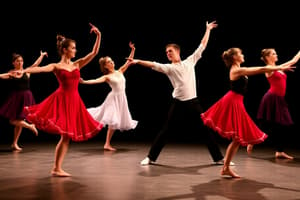Podcast
Questions and Answers
In the Cross-Hold Position, partners touch elbows together across the chest.
In the Cross-Hold Position, partners touch elbows together across the chest.
False (B)
The Shoulder-Waist Position is commonly utilized in Latin American dance genres.
The Shoulder-Waist Position is commonly utilized in Latin American dance genres.
False (B)
Promenade Position involves each person holding the other's upper arm in a cross-hand manner.
Promenade Position involves each person holding the other's upper arm in a cross-hand manner.
True (A)
Cross-Hold Position encourages communication through light pressure applied to connected areas.
Cross-Hold Position encourages communication through light pressure applied to connected areas.
Promenade Position allows for a side-by-side orientation of the couple facing each other.
Promenade Position allows for a side-by-side orientation of the couple facing each other.
Understanding essential dance positions like Cross-Hold and Promenade is not important for dance development.
Understanding essential dance positions like Cross-Hold and Promenade is not important for dance development.
In partnered dances like waltz and cha-cha, the Shoulder-Waist Position involves maintaining straight back and relaxed shoulders.
In partnered dances like waltz and cha-cha, the Shoulder-Waist Position involves maintaining straight back and relaxed shoulders.
The Cross-Hold Position is one of the foundational techniques of dance.
The Cross-Hold Position is one of the foundational techniques of dance.
Shoulder-Waist Position involves a strong grip between the lead dancer's shoulder and follower's hand.
Shoulder-Waist Position involves a strong grip between the lead dancer's shoulder and follower's hand.
In a typical Shoulder-Waist hold, a right-handed leader would hold the female partner's right upper arm.
In a typical Shoulder-Waist hold, a right-handed leader would hold the female partner's right upper arm.
Promenade Position is commonly used in solo dancing styles only.
Promenade Position is commonly used in solo dancing styles only.
Cross-Hold Position involves connecting with the partner's waist while dancing.
Cross-Hold Position involves connecting with the partner's waist while dancing.
Flashcards are hidden until you start studying
Study Notes
Dance Positions: Understanding Essential Alignment Techniques
Dancing is more than just moving your body to music; it's coordinating precise movements with specific alignments called positions. These positions form the foundational techniques of dance, allowing dancers to communicate with each other through their bodies while being expressive and graceful. In this guide, we will explore three crucial positions used across various styles, such as ballroom, salsa, swing, tango, and foxtrot—the Shoulder-Waist Position, Cross-Hold Position, and Promenade Position.
Shoulder-Waist Position
The first position, known as the Shoulder-Waist Position, serves as the primary standing alignment for many partnered dancing styles like waltz, tango, rumba, and cha-cha. This position centers around maintaining a straight back, relaxed shoulders, and a slight bend at the knees. A key element here is the connection between the lead dancer's shoulder and follower's waist. Dancers achieve this by placing one hand on top of the opposite arm and using gentle pressure to maintain contact throughout the dance.
Frame and Connection
In a typical Shoulder-Waist hold, you can expect a right-handed male leader holding his female partner's left upper arm near her elbow and touching her lower abdominal area with his free hand. Conversely, a left-handed lady leader would grip the gentleman's right upper arm and connect with him below the rib cage.
These connections allow the dancers to communicate through subtle shifts in weight, leading and following movement patterns without making physical contacts during each step. Additionally, the frame provides stability for spins and turns.
Cross-Hold Position
Another commonly utilized technique, especially in Latin American genres such as salsa and mambo, is the Cross-Hold Position. Unlike the Shoulder-Waist Position where both hands rest either above or below the elbows, in Cross-Hold, partners touch palms or knuckles together across the chest.
Again, this technique promotes clear communication via light pressure applied to the connected areas. For instance, if a leader wishes to influence his follower's hip motion, he may gently apply pressure to her right wrist, causing a response from the follower's hips. Similarly, a follower can convey a message to the leader regarding balance adjustments or tempo changes simply by shifting her body slightly under the crossed arms.
Promenade Position
Lastly, let us delve into Promenade Position, which is fundamental in social dancing settings when transitioning between various parts of the floor. Also referred to as Closed Waltz Hold or Closed Ballroom Position, this stance usually involves a couple facing each other, often in a side-by-side orientation. Each person holds the other's upper arm in a cross-hand manner, resulting in four points of contact within the embrace: two hands and two elbows.
Promenade Position encourages fluid movement and excellent posture while conserving space—two critical factors during events filled with multiple couples navigating simultaneously. It also allows for a continual feeling of connectedness, whether walking, turning, or stationary.
Regardless of the dance style or occasion, understanding these essential positions forms a solid foundation upon which all dances build upon. As you practice and develop further skills, remember that patience, persistence, and poise remain vital components along this intricate journey of learning how to move within harmonious rhythmic expressions.
Studying That Suits You
Use AI to generate personalized quizzes and flashcards to suit your learning preferences.




